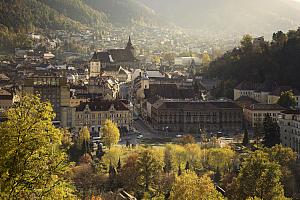Romania Photo of the Day by Dreamstime: Bucovina in autumn colors

The Romania Photo of the Day created in partnership with stock photo provider Dreamstime aims to highlight the best of Romania. From stunning landscapes and popular tourist destinations and landmarks to people, traditions, and food, this series helps you discover Romania one photo at a time. This week, we put the focus on beautiful Romanian landscapes in autumn colors.
The region of Bucovina is an intriguing place located in the Carpathian foothills of northern Moldova, home to beautiful landscapes, rich culture, delicious food, and bountiful history. (Photo source - click on the number to get to the photo 46922007 © Palaghioi Vasile | Dreamstime.com)
When you arrive in Bucovina, you will notice the ethnic and linguistic diversity of the communities living here alongside the Romanians, says holaromania.com: Ukrainians, Poles, Russians, Hungarians, Lipovans, Ruthenians, and Roma have all built communities here, which has led to countless customs, traditions, and folk objects specific to the area.
According to explorebucovina.com, Bucovina's relief includes plains, hills, and, the most impressive of them all, mountains such as the Călimani Mountains - the highest volcanic mountains in the country), the Rarău Massif – which features one of the most interesting geological forms in the Oriental Carpathians chain, called Pietrele Doamnei (The Lady’s Rocks), the Giumalău Mountains – which features plateaus that offer one of the greatest views in the Oriental Carpathians and the secular forest Giumalău with its massive species of coniferous trees.
Some of the best places to explore in Bucovina, according to romaniatourism.com and Libertatea are:
The painted monasteries with their spectacular Byzantine frescos – Voroneț, Moldovița, Sucevița, Humor, Putna, Arbore, Probota
The most famous of these, often called "the Sistine Chapel of the East", is Voroneț Monastery. Erected in 1488, the monastery’s most stunning feature is the fresco of the Last Judgment painted on its façade. The blue paint, which has miraculously never faded, is known throughout the world as Voroneț blue. The artists here worked in isolation, guarding their trade secrets and to this day, the composition of the paint remains a mystery.
The Fortress of Suceava
This is a 14th-century fortification, which according to roamingromania.com, was built by Moldavian ruler Petru Mușat II to serve as his residence and to protect the new Moldavian capital of Suceava from the threat posed by the Ottoman empire. Throughout its long history, the fortress underwent numerous repairs and many modifications that strengthened it against vulnerabilities. Over the nearly two hundred years since it was first erected, the fortress served as the residence for some of the most powerful and influential rulers of Moldavia.
The Ceahlău Mountains National Park
Surrounded by watercourses and dam lakes, Ceahlău Mountain, the Olympus of Romania, displays an incredible concentration of flora - over 2,000 flower species, and wildlife. Fossil limestone, the rock formations Dochia, Cusma Dorobanțului, and the Duruitoarea waterfall are just some of the attractions in the park.
The Cacica Salt Mine
Over 200 years old, archaeologists have said that Cacica is one of the oldest salt mines in Europe. At a depth of 21 meters, you will discover a Roman Catholic Chapel that was built by the miners, and at a depth of 35 meters, there are an Orthodox Chapel and Salt Lake carved directly into the salt rock.













